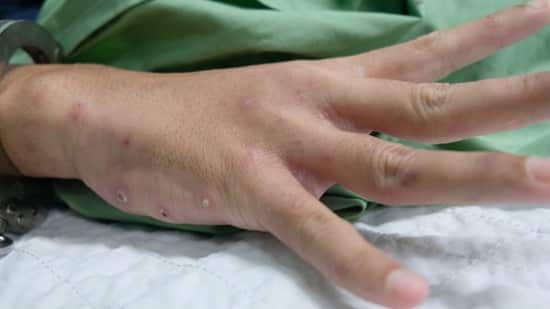Bed bugs and scabies are two types of parasite that feed on human hosts. The symptoms of the two conditions can easily be confused. However, they are not the same, and require different treatments.
Bed bugs are the size, shape, and color of an apple seed. Scabies mites are the size of a pinprick, and white. Mites burrow under your skin, while bed bugs live in your bedding. Bed bug bite marks are larger, and usually less tightly clustered than scabies. Scabies is more contagious than bed bugs.
Skin conditions are embarrassing, and can be difficult to treat. If you’re getting itchy spots, you might want to ignore them. But it’s vital that you figure out what’s causing them so that you can treat them. So, let’s find out the difference between bed bugs and scabies.
Are Bed Bugs a Form of Scabies?
Bed bugs and scabies are two different species of parasite. Bed bugs are part of the genus Cimex, the family Cimicidae, the order Hemiptera, and the class Insecta. This means that they are part of a large group of insect species that have sucking mouthparts.
Scabies isn’t an infection, even though it looks like one. It’s an infestation. It’s caused by tiny human itch mites that burrow into your skin to lay eggs.
The term ‘scabies’ refers both to the visible skin condition, and the mites themselves. This is why the people might think it’s a fungal infection, or something else entirely.
Scabies mites have an entirely different evolutionary origin to bed bugs. The scabies mite is properly termed Sarcoptes scabiei. They are grouped in the subclass Acari in the class Arachnida. This means that they are a tiny mite with jointed legs shorter than, but similar to a spider.
Scabies mites are not a kind of bed bug, and bed bugs are not scabies.
Do Bed Bugs Give You Scabies?
Scabies is spread through physical contact. You have to touch somebody or something that has the mites on it. They are most commonly spread during close contact, where you touch infected skin for an extended time.
Scabies can also be passed on if you share clothing, towels or bedding with an infected person. This is less common than it spreading through physical contact. The mites can live on fabric for a brief time before being passed on.

Can you get scabies from bed bugs? Bed bugs don’t carry the scabies mite. Human scabies mites only live on people. Other species live on other mammals, e.g., dogs. These mites are the cause of mange.
The same applies in reverse—scabies doesn’t attract bed bugs. The two species aren’t related.
Bed Bugs vs. Scabies
Scabies is the name of a condition, but that condition is caused by a mite. Bed bugs are a specific kind of insect. But despite being both parasites, they’re very different.
What Do Bed Bugs and Scabies Look Like?
Bed bugs and scabies look nothing alike. Bed bugs are roughly the same size, shape, and color as an apple seed.
They’re a dark brown color, but they become redder when they feed. That’s from the color of your blood. Their dark coloration helps them hide in cracks and crevices.
They have a thin, rounded body with lines running horizontally across. The rear section of a male is more pointed than that of a female. Their rear section is much bigger than their head in both sexes. Here’s some more info on how to identify bed bugs.
Scabies is much smaller than bed bugs. They burrow under your skin, which means you can’t see them directly. They are the size of a pinprick, and are white.
If you look at them through a microscope, they’re round with tiny legs. They look a little like a shrunken version of a tick. They use the same burrowing mechanism to get under your skin as a tick does.
Do Bed Bugs Live on Your Skin Like Scabies?
Scabies burrows into your skin. This is a safe place for them to live, since you can’t scratch them or squash them. However, bed bugs don’t live on your skin like scabies do.
Instead, they live inside your bed or bedding. They typically stay underneath your mattress. This achieves the same purpose. It’s difficult for you to find and kill them all.
However, a bed bug wouldn’t be able to live on you. They’re too big, and would fall off. Their legs can’t grip onto skin or hair very well. Furthermore, since they’re so big, if they did live on you, then you could easily kill them.
Are Bed Bugs and Scabies Visible to the Eye?
Bed bugs are visible to the naked eye. Being the size of an apple seed, you can see them without any trouble.
What leads people to believe they’re smaller is that they hide. They keep away from threats by hiding in cracks and crevices. You, therefore, don’t see them unless you search for them.
Furthermore, they only feed at night. They know that if they fed during the day, you would chase them away or squash them. So, they wait until the early hours of the morning when you’re deeply asleep.
Scabies are just about visible to the naked eye. They are much smaller than bed bugs, being the size of a pinprick. What makes them difficult to see is that their light coloration. Another factor that makes them difficult to see is that they burrow into your skin.
Are Bed Bugs Contagious Like Scabies?
Yes, but not in the same way. Scabies usually is caught through physical contact. Prolonged physical contact in particular assists the mites spreading from one person to another.
According to the journal Clinical Evidence, scabies exceptionally contagious. They spread quickly in facilities like hospitals and care homes. In developing countries, infection rates reach 50% or higher.
The mites themselves are tiny, and aren’t visible to the naked eye. You can’t avoid them by looking for them. This aids them in spreading from one person to another.

There is also a specific form of scabies called crusted scabies. This occurs in people with compromised immune systems. The skin becomes crusted over because of the large number of mites. This condition is even more contagious.
Bed bugs are contagious. However, they don’t spread through physical contact. Rather, they spread when a female egg-laying bed bug decides to find a new home.
The female has several options. The first is to find another harborage near their existing one. This is the choice that most make. They move from one side of the mattress to the other, for example.
However, they may also decide to spread further. In an apartment complex, they may travel through the walls or under doors to find a new home. They may also hide in your luggage, bags or other belongings to hitch a ride.
Can You Get Bed Bugs and Scabies at the Same Time?
Even though bed bugs don’t give you scabies, you can still have both at once. That’s because bed bugs live in your bed, not on you. When they’re not feeding, they try to avoid you.
Bed bugs typically live under a mattress. Here, they digest their food, mate and rest. They only come out infrequently to feed, or when a female wants to lay eggs.
Scabies live on you, their host. They burrow into your top layer of skin and live just underneath. Here they lay their eggs, too, propagating the next generation of parasites. Scabies and bed bugs, therefore, don’t get in each other’s way.
Scabies also doesn’t present a problem for bed bugs in terms of feeding. Bed bugs will crawl across exposed skin in search of a good place to bite. This is somewhere that has a vein or artery close to the skin surface. Scabies doesn’t stop them from doing so.
The same applies to other parasites. It’s entirely possible to have more than one at once.
Do Scabies or Bed Bugs Carry Disease?
Neither scabies nor bed bugs carry infectious diseases. Bed bugs typically only feed on one or two hosts in the same bed. They don’t go from person to person like mosquitoes do.
The same applies to scabies. Most will spend their life on one person. If the infestation is spread, then the individual mite will have lived on two people. However, it won’t pass any disease on.
Do Scabies Mites and Bed Bugs Crawl or Jump?
Bed bugs have jointed legs just like other similar insects. They move quite slowly unless they’re disturbed. If you disturb them, they scuttle quite fast.
They can’t jump, and they can’t fly. They used to have wings thousands of years ago, but evolved to get rid of them over time. This makes them thinner, helping them get into tight gaps.
Scabies mites are similar. They can crawl on the surface of objects, but only very slowly. They spend most of their time burrowed under your top layer of skin. These mites also can’t crawl, or jump.
Bed Bug Bites vs. Scabies Bites
Bed bug bites are large, red raised lumps. They are similar to other bug bites, so will be familiar to you if you get them.
They swell up because when the bed bug feeds, it injects a small amount of saliva. This saliva numbs the bite area for long enough that they can feed undisturbed. However, they don’t use much, so the bite is usually the size of a mosquito bite.
In terms of size, they vary. Some bites can be as big as a dime, for example, while others are smaller.

Scabies mites lay eggs in the skin. They burrow into the skin, digging and leaving behind a small dry spot. Then they continue along in a line under your skin.
The small dry spot is much smaller than a bed bug bite. However, the line that the mite leaves behind is longer. The bed bug bite may also have an irritated area around it which is much bigger.
Scabies bites are also less raised than bed bug bites. This is a result of the histamine swelling the bite. Scabies bites don’t swell anywhere near as much.
Both Bed Bug Bites and Scabies Bites are Itchy
The saliva that bed bugs use to numb their bites has another effect. Once the initial pain relief wears off, the body notices the saliva. It then causes an immune response, since it’s a foreign substance that the body rejects.
When the immune response begins, and the area swells, it starts to itch. This is called the histamine response. The body sends immunoglobulins (also known as antibodies) to the bite site. These bind to bacteria, viruses and other antigens to aid in their destruction by the body.
As they break down the bed bug saliva, histamine is released. These are another kind of antigen-destroying chemical. They’re also what causes itchiness in bites and other immune responses.
Scabies is itchier than bed bug bites. The name scabies comes from the Latin scabere, which means ‘to scratch’. Itchiness is usually one of the first symptoms to appear.
The itch has several causes. The first is that the scabies mite is burrowing through your skin. This causes irritation. Since it’s under the top layer of skin, you can’t scratch it away.
Do Scabies Bites and Bed Bugs Bites Appear in Clusters?
Both scabies bites and bed bug bites appear in clusters. However, these clusters appear different.
Scabies is variable in appearance. Most commonly, it looks like small pink dots, mottled against the skin. These small dots appear in clusters, with several mites in one location. These clusters are closer together than bed bug bites are.
Scabies bites can also appear reasonably uniform across an entire area, like your back. When this occurs, they look somewhat like chicken pox. In this instance, the clusters are further apart than bed bug bites.
The reason why their bites are usually in clusters is because of the way the mites breed. The females will lay eggs in the burrows that they made. When these eggs hatch, the mites will spread out somewhat, but not too far.
Bed bugs don’t purposefully bite in clusters. They only bite exposed areas. Through the night, it’s likely that a series of bed bugs will bite in the same place. They don’t do so purposefully, but because it’s the easiest place to reach.
Because of their size, the clusters bed bugs make are further apart.
Color of Scabies vs. Bed Bug Bites
Bed bug bites and scabies bites are similar colors. Bed bug bites range from pink to red, becoming darker if you scratch them too much and they become infected.
Scabies mite bites are a similar color. They too can become infected, since the bites are very itchy. This makes you scratch them frequently, which increases the chance of infection.
You have to rely on other things to tell the two different bites apart.
Where do Scabies and Bed Bug Bites Appear?
Bed bugs and scabies are likely to bite different places. Scabies mites can affect any part of the body. They are small enough to crawl almost anywhere without you noticing them. This is especially the case after you’ve had scabies for a while.
However, scabies mites tend to initially attack in several places. These are folds of skin, especially places that become sweaty or damp, such as:
- Between your fingers and toes
- The palms of your hand, and wrists
- Your ankles and the soles of your feet
- Under your armpits, breasts, or around your groin
Bed bugs are much bigger than scabies mites, which limits where they can bite you. Bed bugs usually only bite exposed areas. These are areas that:
- You don’t wear clothes when you’re in bed
- Poke out from under the sheets while you sleep
Usually, this means your legs and arms. They may also bite your side, where it touches the top of your mattress at night. A bed bug’s priority is to find the first patch of open skin they can, and then feed. They won’t explore in search of different places to bite.

